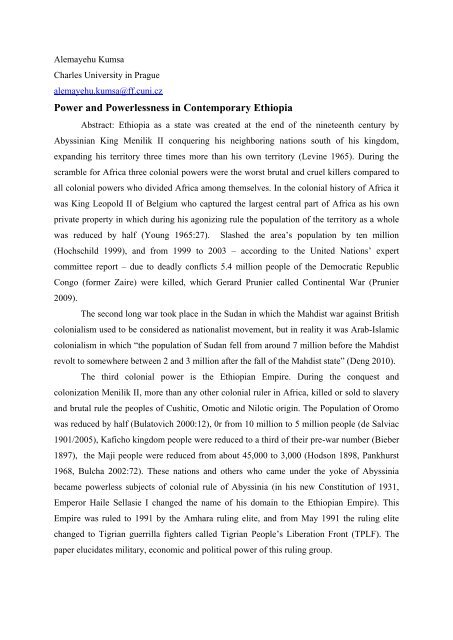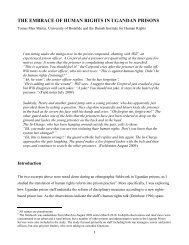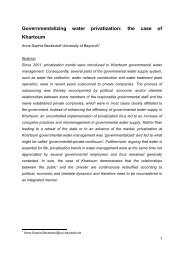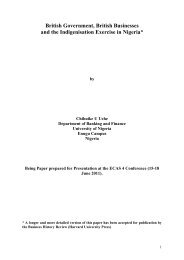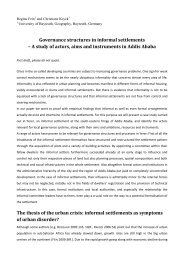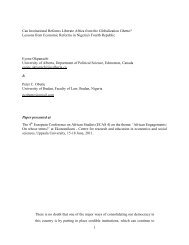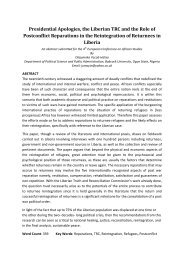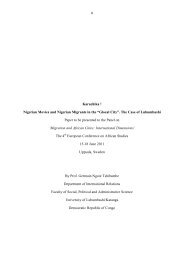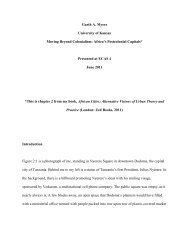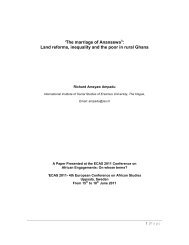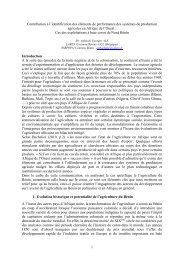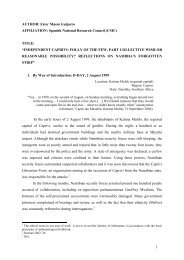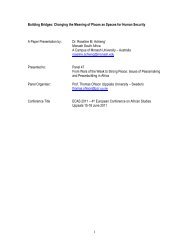Alemayehu Kumsa - Full paper - The Nordic Africa Institute
Alemayehu Kumsa - Full paper - The Nordic Africa Institute
Alemayehu Kumsa - Full paper - The Nordic Africa Institute
Create successful ePaper yourself
Turn your PDF publications into a flip-book with our unique Google optimized e-Paper software.
<strong>Alemayehu</strong> <strong>Kumsa</strong><br />
Charles University in Prague<br />
alemayehu.kumsa@ff.cuni.cz<br />
Power and Powerlessness in Contemporary Ethiopia<br />
Abstract: Ethiopia as a state was created at the end of the nineteenth century by<br />
Abyssinian King Menilik II conquering his neighboring nations south of his kingdom,<br />
expanding his territory three times more than his own territory (Levine 1965). During the<br />
scramble for <strong>Africa</strong> three colonial powers were the worst brutal and cruel killers compared to<br />
all colonial powers who divided <strong>Africa</strong> among themselves. In the colonial history of <strong>Africa</strong> it<br />
was King Leopold II of Belgium who captured the largest central part of <strong>Africa</strong> as his own<br />
private property in which during his agonizing rule the population of the territory as a whole<br />
was reduced by half (Young 1965:27). Slashed the area‟s population by ten million<br />
(Hochschild 1999), and from 1999 to 2003 – according to the United Nations‟ expert<br />
committee report – due to deadly conflicts 5.4 million people of the Democratic Republic<br />
Congo (former Zaire) were killed, which Gerard Prunier called Continental War (Prunier<br />
2009).<br />
<strong>The</strong> second long war took place in the Sudan in which the Mahdist war against British<br />
colonialism used to be considered as nationalist movement, but in reality it was Arab-Islamic<br />
colonialism in which “the population of Sudan fell from around 7 million before the Mahdist<br />
revolt to somewhere between 2 and 3 million after the fall of the Mahdist state” (Deng 2010).<br />
<strong>The</strong> third colonial power is the Ethiopian Empire. During the conquest and<br />
colonization Menilik II, more than any other colonial ruler in <strong>Africa</strong>, killed or sold to slavery<br />
and brutal rule the peoples of Cushitic, Omotic and Nilotic origin. <strong>The</strong> Population of Oromo<br />
was reduced by half (Bulatovich 2000:12), 0r from 10 million to 5 million people (de Salviac<br />
1901/2005), Kaficho kingdom people were reduced to a third of their pre-war number (Bieber<br />
1897), the Maji people were reduced from about 45,000 to 3,000 (Hodson 1898, Pankhurst<br />
1968, Bulcha 2002:72). <strong>The</strong>se nations and others who came under the yoke of Abyssinia<br />
became powerless subjects of colonial rule of Abyssinia (in his new Constitution of 1931,<br />
Emperor Haile Sellasie I changed the name of his domain to the Ethiopian Empire). This<br />
Empire was ruled to 1991 by the Amhara ruling elite, and from May 1991 the ruling elite<br />
changed to Tigrian guerrilla fighters called Tigrian People‟s Liberation Front (TPLF). <strong>The</strong><br />
<strong>paper</strong> elucidates military, economic and political power of this ruling group.
Concepts of Power<br />
At the starting point of our discussion we shall define two key concepts – power and<br />
authority. <strong>The</strong> absolutely basic common core to all conceptions is power: two noted political<br />
sociologists in their book define power as “the capacity of a person or, more often, a group<br />
and institution to be able to manipulate and shape the views and actions of people” (Orum and<br />
Dale 2009:2), and the doyen of the theory of power Steven Lukes gives the concept of power<br />
in these words: “the notion of the bringing about of consequences, with no restriction on what<br />
consequences might be or what brings them about.” (Lukes1979:634-35). <strong>The</strong> power of a<br />
river, for example, is manifested in its causal effects: it erodes a fertile top soil, transports it<br />
from highlands to low lands, like Blue Nile which annually transports millions of top fertile<br />
soil from Oromia highlands to Egypt meandering through central Sudan until it makes delta in<br />
Lower Egypt to finally disappear in the Mediterranean Sea. Similarly, the power of electricity<br />
manifests in the illumination of light bulbs, in heating rooms, and in the operation of<br />
underground railways. This type of power can be identified as natural power. When used in<br />
relation to human beings in social relations with one another, it is attributed to persons or<br />
collectivities or, sometimes, to the system or structures within which they act. All members of<br />
a society affect the society in which they live and one another in countless ways all the time;<br />
any given use of the concept of power – and related concepts such as authority, influence,<br />
coercion, force, violence, manipulation, and so on – picks out ranges of such consequences<br />
that are held to be significant in specific (and related) ways. A conception of power useful for<br />
understanding social relationships must incorporate a criterion of significance – that is, it must<br />
imply an answer to the question: what makes the consequences brought about by a significant<br />
in such a way as to count as power? For such main questions, there is wide range of answers<br />
depending on the view of the authors. For some philosophers, what is essential to power is the<br />
realization of a will or desire. This will yield an intentional conception of power which may<br />
be potential; the British philosopher John Hobbes (1588-1679) described power in these<br />
words in his known book Leviathan (1651): “the power of man (to take it universally,) is his<br />
present means, to obtain some future apparent Good”. “And is original, or instrumental”<br />
(Hobbes 1985:150). Hobbes identified many forms of power, but we shall take only two of<br />
them which are described in this definition:<br />
Natural power is the eminence of the faculties of body, or mind: as Extraordinary Strength,<br />
Form, Prudence, Arts, Eloquence, Liberality, Nobility.
Instrumental are those powers, which acquired by these, or by fortune, are means and<br />
instruments to acquire more: as Riches, Reputation, Friends, and the Secret Working of God,<br />
which men call Good Luck (ibid).<br />
<strong>The</strong> French philosopher Voltaire (1694-1778) said that “power consists in making<br />
others act as I choose” (cited Lukes 1979:635).<br />
Another famous British philosopher Bertrand Russell (1872-1970) defined power as<br />
“the production of intended effects” (Russell 2008:23).<br />
Although there are hundreds, perhaps thousands of more recent definitions of social<br />
power, or power of power over other people in the literature of Social Science, let us see the<br />
definition given by one of the contemporary noted political sociologists who defines power:<br />
as “a capacity of persons to produce intended and foreseen effects on others ” (Wrong1979:2).<br />
An exercise of power typically involves an intentional intervention in a chain of causal<br />
effects. An accidental or incidental effect of an agent‟s action cannot be regarded as an<br />
exercise of power unless it is a foreseen consequence of these actions. A power relation, then,<br />
involves the intention to produce a particular effect or the desire to see particular effect<br />
occurring. Power is an intended or desired causal effect: it is an effect that realizes a purpose.<br />
A power relation cannot, therefore, be identified unless there is some reference to the<br />
intentions and interests of actors involved and, especially, to those of principal.<br />
John Scott in his recent book (2006) elucidates that power is a social relationship<br />
between two agents, who may usefully be called the „principal‟ and „subaltern‟. A principal is<br />
the paramount agent in a power relationship, while subaltern is a subordinate agent. <strong>The</strong><br />
principal has or exercise power, while subaltern is affected by this power (Scott 2006:2).<br />
Another noted Italian political sociologist Gianfranco Poggi (2001) defines power in<br />
similar line and states, “Power is the probability, within a social relationship, of realizing<br />
one‟s own even against resistance, regardless of the basis on which this probability rests”<br />
(pp.15). American sociologist Talcott Parson (1937) already concluded in his now classical<br />
work in which he expressed the role of power as a “generalized means” for attaining whatever<br />
goals one wants to achieve (Parsons:1968, I:263). In his latter more developed theory of<br />
power which was presented in November 1962 to the American Philosophical Society he<br />
states that “power is here conceived as a circulating medium, analogous to money, within<br />
what is called the political system, but notably over his boundaries, into all three of the other<br />
neighboring functional subsystems of a society, ... the economic, integrative, and pattern-<br />
maintenance systems. Specification of the properties of power can best be approached through
an attempt to delineate very briefly the relevant properties of money as a medium in the<br />
economy” (Parsons, 1967:306).<br />
<strong>The</strong> most acknowledged social theorist specializing on the sources of social power,<br />
Michael Mann, asserts that “political powers are those of centralized, institutionalized,<br />
territorial regulation; military powers are of organized physical force where they are<br />
organized” (Mann 1986:11); political power differs from other forms of social power, in that<br />
its concern is one particular area, the “center”. Political power is located in that center and<br />
exercised outward. Political power is necessarily centralized and territorial, and in these<br />
respects differs from the other source. Political power emanates from the state. We may<br />
define state as differentiated sets of institutions and personnel embodying centrality, in the<br />
sense that political relations radiate outward to cover a territorially demarcated area, over<br />
which it claims a monopoly of binding and permanent rule-making, backed up by physical<br />
violence (1986:37). Those who control the state, the power elite, can obtain both collective<br />
and distributive power and trap others within their distinctive “organizational chart” (Mann<br />
1986:27).<br />
When we deal with power it is very necessary to look at the sources of power. Two<br />
political scientists came up with eight sources of power, mainly: (1) power, (2) respect, (3)<br />
rectitude, (4) affection, (5) well being, (6) wealth, (7) skill, (8) enlightenment (Lasswell and<br />
Kaplan 1950:87).<br />
Another American political scientist, the doyen on theory of democracy distinguishes<br />
seven sources of power as: (1) social standing, (2) distribution of cash, (3) wealth and credit,<br />
(4) access to legal means, (5) popularity, (6) control over job, and (7) information (Dahl<br />
1961:222)<br />
Steven Lukes in his already classical work on power (Lukes 1974/2005) distinguishes<br />
three dimensions of power: decision-making power, agenda control, and systematic power.<br />
Decision- making power exists when subordinates are aware of underlying conflict of<br />
interest with power holders but are induced to act in power holder‟s interest, because<br />
resources, such as wealth, charismatic claims, or the threat of violence, allow power holders<br />
to control subjects against their will.<br />
In the second dimension (agenda control), power holders prevail because they control<br />
what issues will be decided and what potential issues are removed from political agenda. Such<br />
process was called by sociologists “non decisions” in which power holders decide not to<br />
decide. Power holders decide agenda for decision in which can be manipulated by strong<br />
lobbyists not to go against their interest for example only in the name of creating work
opportunity; e.g., the steel industry devastates the health of the people of many parts of<br />
Central Europe. Is it not a good example of controlling agenda not to take steps to correct this<br />
situation?<br />
<strong>The</strong> last dimension is systemic power, in which the power holders benefit by structural<br />
arrangements, such as the distribution of wealth or superior political organization.<br />
Subordinates may not be aware of their conflicting interests with the power holders and may,<br />
in fact, be ideologically indoctrinated to accept the authority of the power holders.<br />
<strong>The</strong> second core concept is authority, which needs definition. If we compare power<br />
and authority, we come to the following conclusion: “Power generally refers to a capacity of a<br />
person or, more often, a group and institution to be able to manipulate and shape the views<br />
and actions of people”. “Authority is like power except that it always refers to a set of<br />
institutions, and institutionalized arrangements, in which it operates” (Orum and Dale<br />
2009:2). Authority is that form of power which is accepted as legitimate, that is right and just,<br />
and therefore obeyed on that basis. Thus if members of the Czech society accept that<br />
Parliament has the right to make certain decisions and they regard those decisions as lawful,<br />
Parliament power may be defined as legitimate authority.<br />
Professor Petr Skalník, one of the leading political anthropologists (Kurtz 2001:175),<br />
differentiates power and authority based on his life-long anthropological research in <strong>Africa</strong><br />
(Cameroon, Ghana and South <strong>Africa</strong>), Asia (Lebanon), Europe (Slovakia), and Oceania<br />
(Papua New Guinea). Skalník based his arguments on the anthropological data he collected<br />
from four societies (Ghana, South <strong>Africa</strong>, Slovakia, Lebanon) and elucidates the function of<br />
political institutions. First of all he criticized the ambivalent definition of power given by<br />
many authors starting from Max Weber and the usage of power and authority as<br />
interchangeable concept (Skalník 1989:8). To save the readers from confusions of concepts he<br />
clearly differentiates power and authority. In his view power is state power whereas authority<br />
is legitimate power which the people accepted without the aid of military force, or to use<br />
Weber‟s concept, „state monopoly of physical violence‟. “Power, in my conceptualization,<br />
should be understood primarily as state power. This means the capacity for carrying out<br />
decisions and activities ostensibly on behalf of a whole society by specific state agencies that<br />
have monopoly of use or threat of use of organized violence (ibid). Skalník as political<br />
anthropologist who studied with his colleagues from different parts of the world various types<br />
of polities all around the world and published eight volumes (Kurtz 2001:175) on the origin of<br />
state and its historical development, differentiates polities into two types: state and other<br />
political orders. Authority is a property of the people without accompany of professional
military force. He illuminates authority in these unambiguous words. In this other political<br />
order different from the state, people‟s coexistence does not require state power and<br />
domination of some over others. He called such arrangement authority. “Authority is<br />
legitimate without the backing of power and is voluntarily recognized by all. It is so because<br />
authority is diffuse, truly residing in and exercised by the people” (Skalník 1989:8; 1999:164).<br />
According to the recorded history of North East <strong>Africa</strong>, many nations surrounded on the East<br />
and south of Abyssinia kingdom had various democratic political systems, without standing<br />
army protecting their sovereignty from expanding kingdom of Abyssinia. For a very good<br />
example can be held the conflict between Abyssinia and Somali nation in which the dream of<br />
this kingdom is starting from the 14 th century when it tried to occupy the Western Indian coast<br />
of the Somali territory. <strong>The</strong> Somalis protected their territory against their enemy until the end<br />
of the 19 th century when new fire army reached Abyssinia with the great quantities/qualities<br />
from the then competing colonial powers to which Abyssinia, the only Black <strong>Africa</strong>n state<br />
belonged to participate in the scramble for <strong>Africa</strong>, which changed the power balance between<br />
Abyssinia and Somali. Somali became victims of Colonialism in which their territory was<br />
divided into five colonial administrations and Abyssinia got the largest share – larger than<br />
France, Britain and Italy. Human societies lived for many thousand years without this new<br />
political institution called state, with clear laws to protect the society.<br />
Forms of Social Power<br />
Bertrand Russell (1870-1970), British philosopher, writes that there are various ways<br />
of classifying the forms of power, each of which has its utility. He classified power into two<br />
types – into power over human beings and power over dead matter or non-human forms. He<br />
was interested more in power over human beings. Power over human being was divided into<br />
Priestly power; Kingly power; Naked power; Revolutionary power; Economic power; Power<br />
on opinion, and Creeds as sources of power (Russell 2008:23-144). <strong>The</strong>re are different kinds<br />
of methods of applying power on individual:<br />
1. By direct physical power over his body, e.g. when he is imprisoned or killed;<br />
2. By rewards and punishments as inducement, e.g., in giving or withholding<br />
employment;<br />
3. By influence on opinion, e.g., propaganda in its broadest sense. This can include the<br />
opportunity for creating desired habits in others, e.g., by military drill, but the<br />
difference is not by influence through propaganda but by attraction to the hierarchy<br />
of military structure.
Russell wrote this very important book before the Second war (it was published in 1938).<br />
<strong>The</strong> most influential contemporary political sociologists on theory of power, Dennis<br />
Wrong (1979), Michael Mann (1986 & 1993), and Gianfranco Poggi (2001), also divided<br />
forms of power basically very similar to Russell.<br />
Michael Mann is the most distinguished contributor to our knowledge of theories of<br />
power. In Mann‟s opinion, the object of sociology should be social power, and its aim to chart<br />
the growth and transformation through time and space. In order to pursue this aim, one needs<br />
a general theory of power. That is what he offers in his volumes. Mann illuminates that, social<br />
power emanates from four main sources: meaning systems, material resources, physical<br />
violence, and administrative infrastructure (Gorski 2006:102). Hence, we can distinguish four<br />
types of social power: Ideological power, Economic power, Military power, Political power.<br />
He calls these sources of power IEMP (Mann 1986/2008:22-32).<br />
Mann is the first social theorist who left the usually accepted trinity of power:<br />
political, economic and ideological power. Mann placed military power on the high-ground,<br />
which was sometimes ignored, more frequently treated differently and without an adequate<br />
sense of its nature and significance (Poggi 2006:135). Mann took one step forward from the<br />
traditional typology of power which previous and contemporary experts used to write. We can<br />
elucidate some of these as examples, such as Kant‟s trinity of three evil dispositions,<br />
„hankering after lordship‟, „hankering after possession‟, and „envy‟ or ‛hankering after<br />
recognition‛. Weber‟s „class‟, „status group‟ asserts these forms of power, which his<br />
successors developed to economic, ideological and political power. One of Prof. E. Gellner‟s<br />
best book titles, Plough, Sword, and Book (1988) also belongs to this group of trinity. Mann‟s<br />
typology is quartet.<br />
He explains that these four types are ideal types and that the real „power networks –<br />
the networks of interaction in which power is embedded through which it is exercised – tend<br />
to draw on multiple power sources. One type of power „fertilizes‟ the others through various<br />
channels to control all powers as much as possible in the hands of power holders<br />
Mann elucidates Ideological power which derives from the human need to find<br />
ultimate meaning in life to share norms and values and to participate in aesthetic and ritual<br />
practices (Mann1993:7). Control of ideology that combines ultimate meanings, values, norms,<br />
aesthetic, and ritual brings general social power. Religions provide along with secular<br />
ideologies like liberalism, socialism and nationalism – all grappling with the meaning of class<br />
and nation. Each power source generates distinct organizational forms. Ideological power is
predominantly diffused, commanding through persuasion, a claim to “truth” and “free”<br />
participation in ritual. Its diffusion has two principal forms.<br />
It may be socio-spatially “transcendent“. That means an ideology may diffuse right<br />
through the boundaries of economic, military, and political power organizations. Human<br />
being belonging to different states, classes, and so forth faces similar problems to which an<br />
ideology offers plausible solutions. <strong>The</strong>n ideological power spreads transcendentally to form<br />
anew, distinct and powerful network of social interaction.<br />
Ideological power may solidify the existing power organization, developing its<br />
“immanent moral”. Transcendence is a radically autonomous form of power; immanence<br />
reproduces and strengthens the existing power relations.<br />
Economic power derives from the need to extract, transform, distribute, and consume<br />
the resource of nature. It is peculiarly powerful because it combines intensive, everyday labor<br />
cooperation with extensive circuits of the distribution, exchange and consumption of goods.<br />
All complex societies have an equally distributed control over economic resources. Thus<br />
classes have been ubiquitous. Marx distinguished most basically between those who own and<br />
control the means of production, distribution, and exchange and those who control only their<br />
own labor.<br />
Military power is a social organization of physical force. It derives from the necessity<br />
of organized defense and utility of aggression. On this form of social power the two noted<br />
political sociologists have different views. Michael Mann (1986) asserts that there are four<br />
independent social powers in his „quadripartite‟ formula disconnecting conceptually political<br />
power from the phenomenon of organized violence-military power; the second author<br />
Gianfranco Poggi (2001) sees military power through political or state power because military<br />
organization is one of state institutions which is specialized in physical violence.<br />
Political power derives from the usefulness of centralized, institutionalized,<br />
territorialized regulation of many aspects of social relations. <strong>The</strong> regulations and coercion are<br />
centrally administered and territorially bounded – that is, to the state power (Mann 2008:26.).<br />
Political power heightens bounders, whereas the other power sources may transcend them.<br />
Political relations concern one particular area, the “center”. Political power is necessarily<br />
centralized and territorial, and in these respects it differs from the other sources. In one of his<br />
writings Mann gives his complete definition of state which contains four main elements as<br />
follows:<br />
1. differentiated sets of institutions and personnel, embodying
2. centrality, in the sense that political relations radiate outwards from a center to<br />
cover a<br />
3. territorially demarcated area, over which it exercises<br />
4. a monopoly of the authoritative binding rule-making, backed up by a monopoly<br />
of the means of physical violence (Mann 1984:188).<br />
<strong>The</strong> application of state power by the state elite can be divided into two groups according to<br />
the ways of endorsement: (1) infrastructural power and (2) despotic power.<br />
1. Infrastructural power is what people call in today‟s capitalist democracies „power of<br />
the state‟. Infrastructural power is the capacity of the state actually to penetrate civil<br />
society and to implement logistically political decisions throughout the realm.<br />
Infrastructural power was comparatively weak in the historical societies but expanding<br />
throughout the world slowly expanding its political space, pushing despotic power of<br />
state from scene. We remember that universal suffrage was fully established after<br />
World War II in several of the advanced capitalist states. <strong>The</strong> basic political rights of<br />
groups such as ethnic minorities and women are still increasing. Robert Dahl prepared<br />
interesting figure in one of his books that shows there was no democratic state in the<br />
world in 1860, whereas in 1870 there are only two such states. At the beginning of the<br />
20 th century there were only 8 democratic states and in1990 out of 192 states he<br />
marked 65 as democratic ones (Dahl 1998:8). Freedom House measures for a long<br />
time the democratic development in the world; according to this organization at the<br />
end of 2010, there are 87 free democratic states in the world. In <strong>Africa</strong>, out of 54 states<br />
only 9 of them are free (19 %), 22 are partially free (46 %) and 17 states (35 %) are<br />
authoritarian and not free. As it is known, Ethiopia is included in this last group<br />
(http:// www.ffreedomhouse.org/).<br />
2. Despotic power of the state elite is the range of actions which the elite is empowered<br />
to undertake without routine, institutionalized negotiation with civil society groups.<br />
<strong>The</strong> despotic powers of many historical states have been virtually unlimited. Let us<br />
mention several examples of such despotic state power: the Chinese Emperor as the<br />
Son of Heaven „owned‟ the whole of China and could do as he wished with any<br />
individual or group within his domain; the Roman Emperor, only a minor god,<br />
acquired powers which were also unlimited (except the restricted area of affairs<br />
nominally controlled by the Senate). Some of the monarchs of the early modern<br />
Europe also claimed the divinely derived, absolute power (though they were not<br />
themselves divine) (Mann 1984:189). With this type of despotic power of the state
elite we come to Ethiopia which can provide historical as well as contemporary<br />
examples of such power. <strong>The</strong> last Emperor of Ethiopia, Haile Sellasie, who ruled the<br />
Empire as Regent from 1916-1930, and as Emperor from 1930-1974 (except 1936-<br />
1941the period of Italian occupation) gave the first written constitution for his subjects<br />
in July 1931. Article 5 of this constitution declares that “By virtue of His Imperial<br />
Blood, as well as by anointing which He has received, the person of the Emperor<br />
is sacred, His dignity is inviolable and His power indisputable. Consequently, He<br />
is entitled to all the honours due to Him in accordance with tradition and the present<br />
Constitution.” (Eth. Constitution 1931: art. 5). On the occasion of the signature of the<br />
Constitution Haile Sellasie in his speech declared that “ We, Haile Sellasie I, Emperor<br />
of Ethiopia, have been called to the Empire by the Grace of God and by the<br />
unanimous voice of the people, and having received the Crown and the Throne<br />
legitimately by anointment according to law, are convinced that there is no better way<br />
of manifesting the gratitude which we owe to our Creator, Who has chosen Us and<br />
granted Us His confidence, than render ourselves worthy of it by making every effort<br />
so that he who comes after Us may be invested with this confidence and may work in<br />
conformity with the laws according to the principles established” and continues how<br />
the Constitution was established: “We have, after our elevation to the Imperial Throne,<br />
and second year of Reign in the Year of Grace 1923 (A.D. 1931), unasked and of<br />
Our own free will decreed the present State of Constitution” (Perham 1969: 423-4)<br />
(all emphasis are mine).<br />
In Abyssinia political culture, a person who became victorious in power struggle to capture<br />
the throne will be recognized by the Orthodox Christian Church which Donald Levine calls<br />
“as embodiment of national spirit” (Levine 1965: 267). Haile Sellasie was ascended to power<br />
through the palace coup against Lij Iyasu (Emperor of Ethiopia 1913-1916) organized by<br />
Amhara aristocrats and Orthodox Christian Church who refused to accept a person who is in<br />
his father´s side Oromo, a son of Menelik‟s daughter. Tafari Makonen was known after his<br />
coronation as “Haile Sellasie I, Conquering Lion of the Tribe of Judah Elected of God,<br />
Emperor of Ethiopia” (Ullendorff 1960: VI). After eliminating his political competitors by<br />
political intrigue, killing by poison, and killing political prisoners (it is believed that Haile<br />
Sellasie killed Lij Iyasu in prison during his way via Djibouti to England in 1936) (Warqineh<br />
and Melka 1986:1958 ).<br />
Comparing Colonial Powers
In the contemporary <strong>Africa</strong>, there are two regions which are the worst devastated by<br />
various kinds of war. <strong>The</strong>se two regions according the periods of violent conflict and number<br />
of peoples killed in the war or the causes emanated from war conflict are Central part of<br />
<strong>Africa</strong> and the Horn of <strong>Africa</strong>. <strong>The</strong> causes of these deadly conflicts have rooted in colonial<br />
formation, “there is hardly any zone of conflict in contemporary <strong>Africa</strong> that can not trace its<br />
sordid violence to colonial history and even the late nineteenth century” (Zeleza 2008:1).<br />
Comparing will help us why these two regions are the tragedy of our period. As the French<br />
social philosopher Alexis de Tocqueville reminds us, “without comparisons to make, the mind<br />
does not know how to proceed” (quoted in Almond & Powell 1992:3). Comparison is<br />
fundamental to all human thought as well as being the methodological core of the scientific<br />
method. Comparing colonization processes and the colonial administration of both areas will<br />
give us the experiences of both regions as American great sociologist Martin Seymour Lipset<br />
used to say “an observer who knows only one country knows no countries. Without<br />
comparison, there is no way of knowing whether a particular practices or behavior is unique<br />
to the society in question or common to many” (Fukuyama 2011:18). During the scramble for<br />
<strong>Africa</strong> which was officially signed during the Berlin Conference 1884-85, Leopold II, King of<br />
Belgium, got the largest territory in the central part of <strong>Africa</strong> as his private colony called<br />
„Congo Free State‟ (1885-1908) and the Belgian Congo (1908-1960). Congo Free State under<br />
Leopold II experienced holocaust which is hidden from the world opinion only to enrich one<br />
individual and his group. Until the territory transferred to Belgian state, the Congo people of<br />
the Congo Free State as private property of Leopold II of Belgium suffered one of the worst<br />
war crimes in <strong>Africa</strong>n colonial history. “A population that was estimated to be between 20<br />
and 30 million people at the beginning of the colonial era, was reduced 8.5 million in 1911<br />
and 10 million in 1924, according to official data” (Hochschild Adam: 1998:233). <strong>The</strong> King‟s<br />
own Commission in 1919 published its finding of atrocities committed against the colonial<br />
people by King‟s agents states “Since the beginning of European occupation, the population<br />
has been in a continuous decline owing to a high mortality rate … to a point where it is not<br />
exaggerating to say that, as a whole, the population has been reduced by half” (quoted in<br />
Young 1965:27). <strong>The</strong> death toll was caused by three interrelated causes: (1) murder; (2)<br />
starvation, exhaustion, and exposure, and disease, and (4) another cause of population decline<br />
in areas ravaged by the rubber campaign was a plummeting birth rate (Hochschild 1998:226-<br />
233). Beginning in 1891, the Congolese were required by law to supply labor, rubber and<br />
ivory to Leopold‟s agents. From all forced labor the worst one which devastated the<br />
population was “the collection of wild rubber that resulted in the depopulation of the entire
villages and perpetration of heinous crimes against humanity in the Congo” (Nzongola-<br />
Ntalaja 2003:22). Villages unwilling or unable to meet the assigned daily quotas of<br />
production were subject to rape, arson, bodily mutilation and murder (see photographs of men<br />
holding hands severed from victims, a person looking at the severed hand and foots of his five<br />
years old daughter, and other photographs in Hochschild 1998: between p.116-17). This<br />
horrendous crime against the <strong>Africa</strong>n people happened in their own ancestral land.<br />
Abyssinian Conquest and Colonization of Its Neighboring Nations<br />
Colonialism is colorless alien rule. <strong>The</strong> American scholar on colonialism, Ronald J.<br />
Horvath, who taught at the then Haile Sellasie I University in Finfine (Addis Ababa) (1963-<br />
65) and had done a field research in the Empire adds theoretical bases for the argument of the<br />
existence of colonialism in all civilizations. He criticizes scholars of humanity studies,<br />
because of the lack of general definition of colonialism in the cross-cultural perspective and<br />
gives his own definition based on historical facts from different parts of the world. Horvath<br />
correctly argues that colonialism is not only characteristics of particular civilization (Western<br />
Civilization), and to consider it as peculiar features of particular civilization is “simply to<br />
ignore the full range of reality … every major and minor civilization has sought to extend its<br />
borders and its influence, and Colonialism is not to be equated by only with the civilized<br />
(cultures having cities and literate population); pre-civilized people, too, have colonized”<br />
(Horvath 1972:3). Colonialism is a form of domination – the control by individuals or groups<br />
over territory and/or behavior of other individuals or groups. <strong>The</strong>re exist two basic types of<br />
domination: inter-group and intra-group domination.<br />
In the Ethiopian Imperial state there exist both types of domination. <strong>The</strong> domination of<br />
the Abyssinian government over the colonized peoples like Oromo, Afar, Somali, Sidama,<br />
and other nations is the inter-group domination. At the same time, within the Abyssinian<br />
society there exist the intra-domination of the ruling political elite against the other defeated<br />
group (which is the history of Abyssinian statehood between Amhara and Tigrian elite).<br />
<strong>The</strong>re are two types of colonialism in the world history: (1) overland colonialism and<br />
(2) oversea colonialism. From these types of colonialism the oldest is the overland one, the<br />
second type started at the beginning of the 15 th century when Portuguese colonized the<br />
northwestern corner of <strong>Africa</strong>, a place called Ceuta, in 1415.<br />
Inter-group domination refers to the domination process in culturally heterogeneous<br />
society when the people of one culture dominate the people(s) of different culture, whereas<br />
intra-group domination concerns the situation in which one group of the same culture
dominates the other groups (for example, class political domination of one group by other<br />
group from the same cultural space).<br />
My argument is that colonialism is very old in the human history; it “predates<br />
capitalism, playing an important role in imperial expansion during antiquity” (Boswell<br />
1989:182). Colonialism is the direct and formal political acquisition of states or territories in<br />
the periphery; it is but one form of imperialism (Etherington 1984). Colonization establishes a<br />
hierarchal organization that has monopolistic privileges over peripheral land, labor,<br />
production or trade. It destroys competition in export and import trade.<br />
<strong>The</strong> Ethiopian Imperial state was established by Menelik II of Abyssinia as other<br />
colonial states in <strong>Africa</strong> at the end of the 19 th century, from 1872- 1900, with the highest<br />
human lives lost in the <strong>Africa</strong>n colonization history. <strong>The</strong> first and largest nation southern<br />
neighbor of Abyssinia was Oromo nation which fought against expanding imperial conquest<br />
for more than quarter of a century but finally was defeated like other <strong>Africa</strong>n nations, because<br />
– as the English poet Hilaire Belloc summed up aptly – Whatever happens we have got the<br />
Maxim gun and they have not (Boahen 1990: 4). Let us elucidate what happened to Oromo<br />
fighters to keep out enemy from their territory in the eye witness of two foreigners, Russian<br />
Colonel Alexander Bulatovich who spent many years with the Abyssinian Army in the south,<br />
and French Catholic pastor and „Anthropologist‟ who lived in Oromo land as preacher of<br />
Christianity and observer of Oromo social life before and during the colonial war. <strong>The</strong> longest<br />
bloody conquest war was against the Oromo nation (the second largest nation after Hausa of<br />
West <strong>Africa</strong>), which took place from 1872 to 1899 (Bulcha 1988:34). This conquest war<br />
reduced the population of Oromo nation from 10 million to 5 million people (de Salviac<br />
2005); half of the nation‟s people (Bulatovich 2002:12) were killed, captured in the battle and<br />
sold to slavery by King Menelik – the Butcher of Oromo. Other neighboring nations of<br />
Oromo also faced holocaust in the hand of Menelik predatory army, such as Kaficho kingdom<br />
(67 % of its people), Gimira nation (80 %) and Maji (90 %) were killed or sold to slavery<br />
(Pankhurst 1968:111). <strong>The</strong> peoples south of Abyssinia were defeated and included into the<br />
new imperial state called Ethiopia; similarly to the medieval period in East Europe they<br />
became serfs and sold as slaves under Menelik II rule, the founder of the Empire.<br />
<strong>The</strong> subjugated people under the Abyssinian colonial yoke faced many harsh notorious<br />
actions, mainly the Maji and Kaffa people – southern neighbors of the Oromo nation. Slave<br />
raiding and lucrative slave trade brought great amount of wealth. Since the Amhara<br />
colonization until the invasion of Italy (1936-1941) slave trade reached a climax of profit<br />
depopulating the region. „Eye-witnesses at Maji and at other places near Sudan border stated
that whole areas of the country had been completely devastated and that the remains of<br />
villages overgrown with bush could still be seen” (Perham 1969:220).<br />
During the Menelik´s conquest war and raiding the people to be sold as slaves the<br />
inhabitants of former strong kingdom of Kaffa suffered extremely: “raiding automatically<br />
declined the population having been almost exterminated‛” (Pankhurst 1968:111). In 1938,<br />
the population of Bonga, the former capital of the Kaffa kingdom, was 3,000 out of which<br />
about only 200 were Kaffa (Huntingford 1955:105).<br />
<strong>The</strong> chance of the Oromo people was not different from other sister neighboring<br />
nations, who had fallen under the Abyssinian subjugation: they were sold as slaves in the<br />
market, given as a wedding gift, during marriage between royal families, as domestic slaves<br />
and male as eunuchs. At one time Menelik and Taitu owned a large estate of 70,000 slaves.<br />
<strong>The</strong> Oromo people tried all alternatives to protect themselves from this horrendous, barbaric<br />
act against them. Some fled to the forest, whereas some took refuge in British Sudan, Kenya<br />
and British Somalia to escape slavery. <strong>The</strong> first exodus of refugees from Oromo land to<br />
escape slavery and Gabbar system in history started at this time (Bulcha 1988:41).<br />
<strong>The</strong> land of Oromo and other colonized nations was measured into Gasha (1 gasha =<br />
40 hectares) and divided to Naftanya (lit. gun-carrier, i.e., armed settler), Amhara who came<br />
as soldiers, priests, colonial governors, irregular fighters and others. This confiscation of the<br />
land belonging to the colonized people and its distribution for Amhara was known as Gabbar<br />
system.<br />
<strong>The</strong> colonial government introduced the Balabbat system in which the land was<br />
divided into three parts, the author of the topic tells us „Immediately after the conquest, the<br />
northern rulers divided the southern lands into three, theoretically equal, parts according to a<br />
tradition principle known as Sisso, meaning one third. <strong>The</strong>y confiscated two-third outright,<br />
leaving the last third to the indigenous population“ (Markakis & Ayele 1986:33). This two-<br />
third land of colonized peoples was divided to Naftanya according to their position in the<br />
government.<br />
A governor received 1,000 Gasha, a Fitawrari (commander of the front) 300 Gasha, a<br />
Qanyazmach (commander of the right) 150 Gasha (Melba 1980:48), and soldiers according to<br />
their ranks: „an ordinary soldier, depending on length of service received from one to three<br />
Gasha; and captain of fifty men was granted up to five Gasha; commander of one hundred<br />
received up to twenty Gasha of land” (Markakis 1974:113).<br />
<strong>The</strong> peoples of the colonized countries in such system were divided among the<br />
Abyssinian armed settlers (colonizers) and obliged to pay the major part of their products – up
to seventy-five percent from their harvest – as tribute to the new landlords (Bulcha 1988:42).<br />
Each Gabbar (one who pays taxes or tributes) faced different kinds of onerous works for his<br />
new master. <strong>The</strong> Gabbar´s obligations were not limited; all necessary works were ordered by<br />
the Naftanya. <strong>The</strong> Gabbar works (plough, weeding, harvesting), on the field some day in the<br />
week, builds fences, kraal for his cattle; meanwhile Gabbar‟ wives and children also have<br />
many duties to fulfill for wives of Naftanya such as fetching water, grinding grains, collecting<br />
fire wood, washing clothes, generally all household duties for the families of Naftanya.<br />
<strong>The</strong> colonization and confiscation of land established a new group of people without<br />
land ownership in a country where 85 % of the population are peasants who live on<br />
agriculture. <strong>The</strong> main cause of the 1974 revolution was the question of landownership in<br />
colonized territory of the Empire. Horowitz wrote about the 1974 Revolution, “in Ethiopia, a<br />
major effect of a land reform was to take land from Amhara and distribute it to the Galla, and<br />
for a time the revolution is suspected of being a Galla plot” (Horowitz 1985:8). Galla is<br />
misnomer for Oromo which entered literature via Abyssinian writers, but Oromo never used it<br />
as their own name.<br />
Starting from the creation of this Empire at the end of the 19 th century until today the<br />
political, economic, military and ideological power is in the hands of the Abyssinian state<br />
elite; the only difference is that starting from 1991the circulation of power changed from the<br />
Amhara power elite to the Tigrians. <strong>The</strong> power circulation between these two groups of<br />
Abyssinians is part of their political culture. Amhara ruled from 1270-1872, the Tigrians from<br />
1872-1889, then again Amhara 1889-1991.<br />
<strong>The</strong> Tigrians came to power through armed struggle in 1991, at the end of the cold war<br />
with the blessing of Euro-Americans and it seems they are prepared to rule for a long time –<br />
according to how they structured their empire economically, militarily and ideologically.<br />
Political Power in Ethiopia<br />
During the military rule (1974-1991) many National Liberation Fronts fought to oust<br />
the brutal government of Mengistu Haile Mariam. <strong>The</strong> main strong liberation fronts were the<br />
Eritrea People‟s Liberation Front (EPLF) with political program of liberating Eritrea from<br />
Ethiopian and establish the Eritrea Republic; the Oromo Liberation Front (OLF) aimed to free<br />
Oromo from the shackle of Abyssinian colonial rule and to establish the Republic of Oromia,<br />
the Tigrai People‟s Liberation Front (TPLF) declaring in its original political program to<br />
establish the Republic of Tigrai; later it is alleged to change its goal to rule the Empire. At the<br />
end of the cold war the Mengistu Government collapsed because of many internal and
external reasons and EPRF expelled the Ethiopian Army from the Eritrean soil and became an<br />
independent state. In Ethiopia, the Amhara state elite lost their state power and the Tigrian<br />
captured the Menelik palace in the Center of Oromia. OLF accepted the American<br />
Government promise in which during the conference in London on the future of Ethiopia<br />
organized by USA and chaired by Herman Cohen-Undersecretary of state it was said clearly<br />
that “without democracy, no help”. <strong>The</strong> OLF leaders, hoping to end the century old colonial<br />
rule in peaceful way participated as junior partner in TPLF led government for one year; when<br />
it realized that there is no window for democratic way of solving the problem, it resigned<br />
from the government to struggle as opposition party. <strong>The</strong> TPLF declared war on it and from<br />
1992, low-level armed struggle occurs in Oromia and the Somali region of Ogaden in<br />
Ethiopia. <strong>The</strong> American Government´s phrase “without democracy, no help” seems to be a<br />
false promise, because now TPLF is already in power for 20years, and when we look at the<br />
USA foreign policy it seems that the opposite is true. As we know and all foreign observers<br />
certify, each five years there were parliament and local elections and the results speak for<br />
themselves, to quote only the 2010 parliament election result: according to the Ethiopian<br />
National Election Commission the ruling party garnered 99.6 % votes (Tronvoll 2011:121-<br />
136): Political power is completely monopolized by the TPLF.<br />
Military Power in Ethiopia<br />
In history of state making and its existence, armed people played a key role. <strong>The</strong>y are many<br />
different types of theories of state (Carneiro 1970, Krader 1968, Oppenheimer 1975). From all<br />
theories of formation of the state Oppenheimer theory fits the Ethiopian state formation which<br />
was established through conquest and plunder and survives until today by unlimited<br />
exploitation of the conquest nations. Oppenheimer continues to explain its origin and<br />
developments “the State, completely in its genesis, essentially and almost completely during<br />
the first stages of its existence, is a social institution, forced by a victorious group of men on a<br />
defeated group, with the sole purpose of regulating the domination of the victorious group<br />
over the vanquished, and securing itself against revolts from within and attacks from abroad.<br />
Teleologically, this domination had no other purpose than the economic exploitation of the<br />
vanquished by the victors” (Oppenheimer 1975: 8). <strong>The</strong> Abyssinian conquest and<br />
colonization of its neighboring nations created in the new Imperial state two groups of people,<br />
the victorious (Abyssinians) and vanquished (colonized) people, which European<br />
Anthropologists who studied Ethiopian society called true Ethiopians and those forced to be<br />
Ethiopians. Huntingford G. W. B.(1955) in his studies Ethiopians and various vanquished<br />
nations in Ethiopia presents the census of the population as follows:
Ethiopians 32.6%<br />
Oromo 42.7%<br />
Sidama, etc, 10.1%<br />
Somali 6.0%<br />
Negroid and Nilotes 6.6%<br />
Afar 2.0% (Huntingford 1955: 23)<br />
During Haile Sellasie, majority of Army echelon had been filled by Amhara individuals, but<br />
few individuals from vanquished nations reached the highest rank in military hierarchy, in the<br />
era of military government the space for vanquished people relatively expanded.<br />
Contemporary Ethiopian government and military is completely controlled by Tigrians, who<br />
came to power through the power of a gun in 1991. Tigrians are 6% of the Ethiopian<br />
population of 82 million. When Tigrian People‟s Liberation (TPLF) captured the state power,<br />
Ethiopian Armed Forces were completely demobilized and its officers thrown to prison. TPLF<br />
militia became the country‟s Defence Force. Today there is no Army General from Oromo<br />
and Amhara nations (whose population is more than 65% of the country‟s inhabitants). All<br />
military commanders are Tigrians except two individuals who are from minority group. René<br />
Lefort, the author of Ethiopia: An Heretical Revolution? (1981) a long time observer of<br />
Ethiopian politics in his recent article summarized the role of Tigrian Army if there will be<br />
peoples‟ revolution in Ethiopia as in North <strong>Africa</strong> and Middle East in these words “If the<br />
Arab uprisings soon broke through the wall of fear, it is probably because the demonstrators<br />
sensed that their own strength would lead the army to distance itself from the ruling power<br />
and thus deprived it of its only trump card-repression. But how would the command of the<br />
Ethiopian army-monopolized by Tigrians-react in the same circumstance? <strong>The</strong> answer is<br />
almost unanimous- it would defend the regime to the last bullet, because its position as well as<br />
the advantages it brings lie entirely on the regime remaining in power ” (Lefort 2011: 5).<br />
Prime Minister Meles Zenawi also in the line of Abyssinian political culture told to the<br />
opposition parties that he fought and got the state power and if they want to come to power<br />
they must go to the mountains to push him off from power. All leaders of Abyssinia in<br />
modern history came to power by bullet of a gun.
References<br />
(http:// www.ffreedomhouse.org/images/File/fiw/FIW_2001_booklet.pdf) assessed<br />
29.5.2011<br />
Almond Gabriel & Powell Bingham G. jr. (Eds.). Comparative Politics Today: A World<br />
View. New York: Harper Collins Publishers.<br />
Bean Richard. 1973. War and Birth of the Nation State. <strong>The</strong> Journal of Economic History,<br />
Vol. 33, No 1. pp.203-221.<br />
Boahen, A. Adu. 1987. <strong>Africa</strong>n Perspectives on Colonialism. Baltimore: <strong>The</strong> John Hopkin<br />
University Press.<br />
Carneiro Robert L. 1970. A <strong>The</strong>ory of the origin of the State. Science , 21 August 1970, Vol.<br />
169, 733-738.<br />
Dahl Robert A. 1998. On Democracy. New Haven & London: Yale University.<br />
Fukuyama Francis. 2011. <strong>The</strong> Origins of Political Order: From Prehuman Times to the French<br />
Revolution. London: Profile Books LTD<br />
Hobbes, Thomas. 1985. Leviathan. London: Penguin.<br />
Hochschild Adam. 1999. King Leopold‟s Ghost: A story of greed, terror, and heroism in<br />
Colonial <strong>Africa</strong>. Boston & New York: A Mariner Book.<br />
Huntingford G.W.B. 1955. <strong>The</strong> Galla of Ethiopia, <strong>The</strong> Kingdoms of Kafa and Janjero.<br />
London: International <strong>Africa</strong>n <strong>Institute</strong>.<br />
Krader Lawrence. 1968. Formation of the State. New Jersey: Prentice-Hall, INC.<br />
Lefort René. 1983. Ethiopia: An Heretical Revolution? London: Zed Press.<br />
Lefort René. 2011. “Beka” (“enough”). Will Ethiopia be next? Open Democracy, May<br />
26,2011.<br />
Levine Donald N. 1974. Greater Ethiopia: <strong>The</strong> Evolution of Multiethnic Society. Chicago &<br />
London: <strong>The</strong> University of Chicago.<br />
Lukes, Steven. 1974/2005. Power: A radical view. London: Palgrave, Macmillan<br />
Machiavelli, Niccoló. <strong>The</strong> Prince. London: Penguin. 1995.<br />
Mann Michael, 1984. <strong>The</strong> Autonomous Power of the State: Its Origins, Mechanisms and<br />
Results. Archives européennes de sociologie , Vol.25, 1984, pp. 185-213<br />
Mann, Michael. 1993. <strong>The</strong> Sources of Social Power. Volume, II. <strong>The</strong> rise of classes and<br />
Nation- state, 1760-1914. Cambridge: Cambridge University Press.<br />
Mann, Michael. 2008. <strong>The</strong> Sources of Social Power. Volume 1. A History of Power from the<br />
beginning to A.D. 1760. Cambridge: Cambridge University Press. 16 th printing<br />
Oppenheimer Franz. 1975. <strong>The</strong> State. Montréal: Black Rose Books
Orum Anthony M. and Gale John G., 2009. Political Sociology: Power and participation in<br />
the Modern World. Oxford: Oxford University press.<br />
Parson, Talcott. 1967. Sociological <strong>The</strong>ory and Modern Society. New York: <strong>The</strong> Free Press.<br />
Parsons, Talcott. 1937/ 1968. Volume, I. <strong>The</strong> Structure of Social Action: A Study in Social<br />
<strong>The</strong>ory with special reference to a group of recent European writers. New York: <strong>The</strong> Free<br />
Press.<br />
Parsons, Talcott. 1937/ 1968. Volume II. <strong>The</strong> Structure of Social Action: A Study in Social<br />
<strong>The</strong>ory with special reference to a group of recent European writers. New York: <strong>The</strong> Free<br />
Press.<br />
Parsons, Talcott. 1963. on the concept of Political Power. Proceedings of the American<br />
Philosophical Society, Vol. 107, No., 3 (June, 1963<br />
Poggi Gianfranco. 2006. Political power un-manned: a defence of Holy Trinity from Mann‟s<br />
military attack. In Hall, John, A., Schroeder Ralph (Eds.). 2006. An Anatomy of power: <strong>The</strong><br />
social theory of Michael Mann. Cambridge: Cambridge University Press.<br />
Poggi, Gianfranco, (2001).Forms of Power. Cambridge: polity Press.<br />
Prunier Gérard. 2009. From Genocide to Continental War: <strong>The</strong> „Congolese‟ Conflict and the<br />
Crisis of contemporary <strong>Africa</strong>. London: Hurst & Company.<br />
Warqneh Waldeyohanis ena Melka Gemachu 1986. Oromia: yatadabaqewu yagif taarik.<br />
Addis Ababa: Commercial Printing Company.<br />
Young Crawford. 1965. Politics in the Congo: Decolonization and Independence. Princeton:<br />
Princeton University Press.


